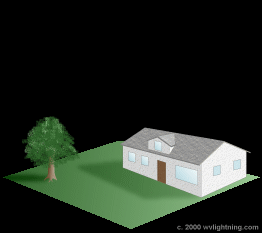MYTH: Lightning always strikes the tallest object.
|
In September of 2025, my work is generating the most income it ever has in my career. Yet, I'm being forced to shut down my successul operation, against my will, due to one cause alone: 95% of that revenue is being stolen by piracy and copyright infringement. I've lost more than $1 million to copyright infringement in the last 15 years, and it's finally brought an end to my professional storm chasing operation. Do not be misled by the lies of infringers, anti-copyright activists and organized piracy cartels. This page is a detailed, evidenced account of my battle I had to undertake to just barely stay in business, and eventually could not overcome. It's a problem faced by all of my colleagues and most other creators in the field. |
TRUTH: Lightning can strike just about anywhere! The following is a zoomed-in area of a photo taken in Greentree, Pennsylvania of a cloud-to-ground lightning strike only 230 feet away:

(Click for full photo)
The lightning hit the ground only 50 feet away from the metal light pole on the left. Not only that, but under 200 feet from where the lightning struck ground is this four-story office building:

And take a look at this photo of lightning striking the side of a tower, more than 50 feet below its top in St. Albans, WV!

Another compelling example is this mountaintop location just north of downtown Charleston, WV (pictured below). A tall tower used by the airport is situated on the peak. On one occasion lightning bypassed the tower, which is much taller than the surrounding trees, and struck a tree less than 40 feet away! The tree sustained heavy bark damage and later died from its injuries. Below is a photo of the location:

Cloud-to-ground lightning strokes initiate high in thunderstorms, miles above the surface where ground objects have no effect. Even after initiation of the discharge, the downward-moving stepped leader is 'blind' to objects on the ground until it is very close to the ground, within 50 to 100 feet. At that distance, lightning will strike within the very small area it is already descending in, regardless of any objects nearby that would be thought to divert the strike. For example, a photograph exists of a lightning strike to the Merchandise Mart building in downtown Chicago, very close to the 1,700 foot tall Sears Tower.
Nonetheless, there is a small bit of truth to this myth. Extremely tall structures like towers and skyscapers are indeed more susceptible to strikes, because they significantly reduce the insulating air gap beween cloud and ground. In addition, very tall structures and towers often inititate ground-to-cloud lightning discharges that start at the structure tip and propagate upward into the cloud (read more about this "upward moving" lightning).
If the lightning in the photo above were to have come down just a little closer to the pole, then it might have connected to the pole in its last reaches toward earth. If the nearby office building had been tall skyscraper, it too may have drawn this strike to it. But to lightning, 'small' objects on the ground (like the light pole, and even the office building) are almost 'invisible' until the descending stepped leader gets very close to them, possibly less than 50 to 100 feet or so:
 This extreme-slow-motion animation depicts the stepped leader descending
to meet the upward leaders extending from the ground, and the first and subsequent return strokes. In reality, this whole process takes only a small fraction of a second.
In other words, cloud-to-ground lightning is 'blind' to the details of earth's surface and doesn't 'make a decision' on what it will strike until it has almost reached the ground. If something tall happens to be at that exact location, it may very well take the hit. But if that tall object is just a little farther away, the lightning will just bypass it and hit the ground, or anything (or anyone) else that might be in the way!
What does all this mean? Don't assume that you're safe from lightning if there is something tall or large nearby.
Related myths include those about lightning only striking metal (or conductive) objects, and the myth that carrying, wearing or standing near anything metal will increase chances of being hit by lightning.
READ: More Weather Myths | Weather Library Home
 About the Author: Dan Robinson has been a storm chaser, photographer and cameraman for 33 years. His career has involved traveling around the country covering the most extreme weather on the planet including tornadoes, hurricanes, lightning, floods and winter storms. Dan has been extensively published in newspapers, magazines, web articles and more, and has both supplied footage for and appeared in numerous television productions and newscasts. He has also been involved in the research community, providing material for published scientific journal papers on tornadoes and lightning. |
See Also:
GO: Home | Storm Chase Logs | Photography | Extreme Weather Library | Stock Footage | Blog
Featured Weather Library Article:
|